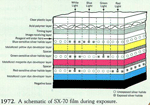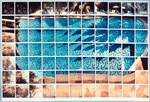Today, the instant camera has regained popularity amongst the youth as a way to take and share memories with friends. It captures moments in film that can be used to decorate space or just kept as a keepsake in a photobook like the olden times.

The new style of instant film also changed the way photos were developed. The integral instant color film sheets took place of the positive and negative films. The color film sheets are composed of multiple color layers: top layer is sensitive to blue light, middle is sensitive to green light, and bottom is sensitive to red light. When the film is exposed to light, the photons react to the layers to create the chemically based record that is squeezed between a bottom black base layer and four additional layers: acid, timing, image, and reagent layer.
Polaroid was not the only company that was producing instant cameras. Japan’s company, Fujifilm, started manufacturing their own line of instant cameras since 1900s. One of the most popular models of instant cameras recently has been the Fujifilm Instax Mini 8. The small compact size and pastel colors appeal to the generation of having an aesthetic style and photos.

In terms of designers and artists, instant cameras became popular amongst them as well. Andy Warhol was captivated by the colors and used it for a series of instant portraits. Another artist, David Hockney created a series of landscape panoramas made up of entirely polaroid films. The speed and ease of the self-developing film increased the desire for photographers in the advertising and cinema world who could assess light, shade and composition on set before they actually started shooting with more conventional cameras.

polaroid collages
The advancement of technology decreased the popularity of the instant camera but it has been rediscovered and become a trendy piece of technology with a new audience.
